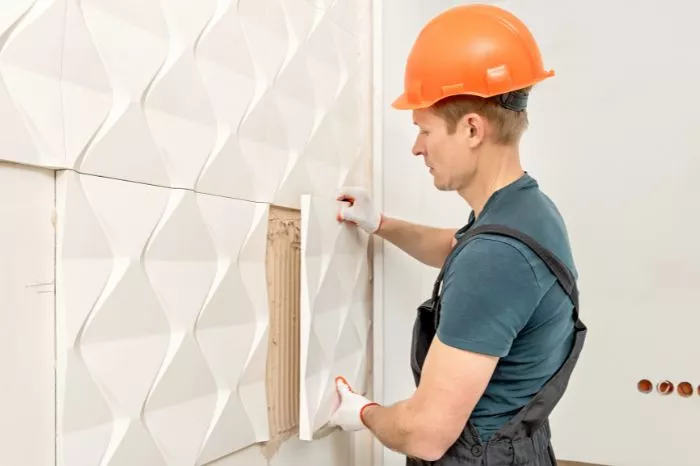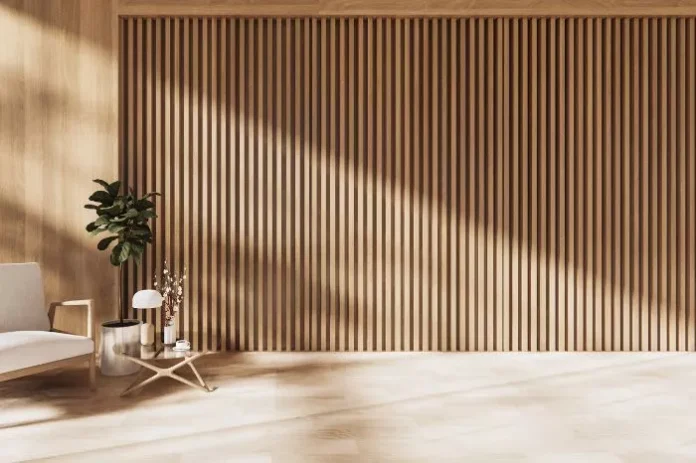Picture this. It’s Friday evening, your walls feel painfully plain, and you’re scrolling for a weekend project that does not wreck your budget. Enter 3D wall panels, the fastest way to give any room showroom depth, texture, and character without calling a pro.
Out of the dozens launching for 2025, we’ve narrowed the field to three clear winners based on installation ease, realism, moisture defense, and upkeep. Invest one Saturday and you can greet Monday with a room that looks straight out of a design magazine.
So, why are these panels 2025’s fastest style hack? They add instant depth and shadow play, even on builder-grade gypsum, and can elegantly hide minor cracks or texture flaws. With rental-friendly peel-and-stick options that pop off cleanly, it’s a reversible trend choice you can repaint or remove when your style shifts.
What Are 3D Wall Panels?
3D wall panels are decorative wall coverings designed to add depth and visual interest to any indoor space through three-dimensional patterns and textures.
Unlike traditional flat wall treatments like paint or wallpaper, these panels create dynamic shadow effects and tactile surfaces that elevate ordinary walls into stunning focal points.
Crafted from high-quality, lightweight, and paintable PVC, 3D wall panels offer durability and water resistance, making them ideal for various residential and commercial interior applications. Each panel measures approximately 19.7 by 19.7 inches and covers about 2.7 square feet, making installation quick and DIY-friendly without requiring professional help.
These panels come in contemporary wave designs, but the range can include diverse geometric and abstract patterns that complement modern, minimalist, or industrial interior styles.
Beyond aesthetics, 3D wall panels also help protect walls, can cover imperfections, and offer a cost-effective way to refresh spaces such as living rooms, kitchens, bedrooms, offices, and commercial settings.
Pros and Cons of 3D Wall Panels

When considering 3D wall panels for your 2025 home refresh, it’s important to weigh the advantages against potential drawbacks.
These decorative elements have revolutionized interior design, but like any home improvement product, they come with both benefits and considerations. 3D wall panels offer an immediate visual transformation that can elevate any space from ordinary to extraordinary.
They provide a cost-effective alternative to major renovations while delivering professional-grade results. However, understanding both sides will help you make an informed decision for your specific needs and space.
| Pros | Cons | Considerations |
| Quick and easy installation – most DIY-friendly | Requires a smooth, clean wall surface for best results | Wall preparation time may be needed |
| Adds significant visual depth and dimension | It can make small rooms feel smaller if overused | Best used as accent walls in compact spaces |
| Wide variety of designs and materials available | Premium materials can be expensive | Budget-friendly options exist with great quality |
| Hides wall imperfections and minor damage | Difficult to hang heavy artwork on a textured surface | Plan furniture and décor placement in advance |
| Provides acoustic benefits and sound dampening | Some materials may not be suitable for high-moisture areas | Choose appropriate materials for bathrooms/kitchens |
| Eco-friendly options available (bamboo, recycled materials) | Lower-quality panels may fade or warp over time | Invest in reputable brands for longevity |
| Increases perceived home value | Removal may damage the drywall underneath | Consider this if renting or planning to move |
| Low maintenance – easy to clean and dust | Limited flexibility once installed | Choose timeless designs over trendy patterns |
Quick-Glance Comparison
Before diving into detailed reviews, this table offers a clear side-by-side look at how our top three contenders stack up. Use it to quickly identify which panel best aligns with your project’s specific needs, from installation method to ideal room placement.
This at-a-glance summary helps streamline your decision-making process.
| Criteria | WallArt “Hexa” Plant-Based Tile | PlantFiber Ecoresin “Ripple” | AcoustiForm “Wave” Acoustic Panel |
| Install Ease | ★★★★☆ Peel-&-stick | ★★★☆☆ Construction adhesive | ★★★★☆ Hidden Z-clip |
| Texture Realism | 12 mm honeycomb shadow | 10 mm organic ripple | 15 mm deep curved grooves |
| Moisture Resistance | Good with coated plant fiber | Excellent with resin core (ASTM D570 < 0.25%) | Good with MDF core + polyurethane sealer |
| Maintenance | Wipe clean | Soap & water | Dust & vacuum |
| Best Room | Rentals, living rooms | Baths, kitchens | Home theaters, offices |
How to Choose the Right 3D Wall Panel for YOUR Space
Choosing the right panel is about balancing aesthetics with practicality. Your room’s purpose, your budget, and your long-term design vision all play a critical role. Before you commit, carefully weigh the following factors to ensure your choice is both beautiful and functional for years to come.
- Budget: Fiberboard tiles are budget-friendly, starting around $3.50 per square foot, while high-NRC acoustic panels can reach up to $12.
- Texture Depth: Subtle 6-12 mm textures work well in tight hallways, whereas deeper 15 mm+ patterns make a powerful statement on large feature walls.
- Eco Score: Look for panels made with recycled feedstock or certified under programs like GreenGuard or FSC for a sustainable choice.
- Acoustic Needs: Home theaters and offices greatly benefit from panels with a Noise Reduction Coefficient (NRC) rating above 0.65 to absorb sound.
- Finish: Choose between paintable panels for unlimited color control or factory-finished options for zero drying time and instant results.
Our top three selections address specific, common needs from eco-friendly design to acoustic control. However, the world of 3D panels is vast, especially for high-moisture areas.
For a wider variety of waterproof and pre-finished options, exploring a comprehensive catalog of Dundee Deco premium PVC wall panels can help you find hundreds of ready-to-install designs suited for kitchens and baths. These options often provide durability and simple maintenance without sacrificing style.
Key Insight: Your choice isn’t just about looks. Match the panel’s material, like fiber, resin, or an acoustic core, to your room’s specific function and technical needs for a successful, long-lasting design upgrade.
In-Depth Reviews & Real-World Tips
1. WallArt “Hexa” Plant-Based Panel
These 20 × 20-inch tiles are pressed from sugar-cane bagasse, a renewable resource, and come primed white and ready for any interior latex paint. Their ultra-lightweight design makes ceiling installations entirely feasible, and the peel-and-stick backer significantly speeds up application.
The softer fiber core can dent under a heavy paint roller, so use a light touch during finishing. A pro tip is to prime the tile edges before hanging to simplify your final coats and hide seams.
2. PlantFiber Ecoresin “Ripple” Panel
Sold in 24 × 48-inch translucent resin sheets, these panels boast impressive moisture-proofing with an ASTM D570 water-absorption rating below 0.25%. This makes them approved for commercial wet zones and ideal for home use.
For a stunning visual hack, back-light the panels with warm LED strips to animate the rippled texture, creating a perfect ambiance for spa-style bathrooms or modern kitchens.
3. AcoustiForm “Wave” Acoustic Panel
These 12 × 48-inch panels feature a sculpted MDF face bonded to a recycled PET felt backing, achieving an impressive NRC of 0.75. The deep, curved flutes are engineered to scatter and trap sound frequencies, making them ideal for a surround-sound den or home office.
For a DIY twist, try alternating two different stain colors on every other panel; the resulting color-blocked pattern doubles as functional wall art.
Pro Tip: Elevate functional panels into wall art. Try back-lighting translucent resin panels for ambiance or alternating stain colors on acoustic panels to create a stunning, sound-absorbing feature wall.
Choosing Waterproof Panels for Showers & Tubs
When selecting panels for high-moisture areas like showers, look for an ASTM D570 water absorption rating below 1% and a closed-cell or solid resin core. The IPX rating seen on lighting is less relevant for wall panels.
For a successful installation, always seal seams with 100% silicone, flash edges above the showerhead height, and ensure the room is ventilated after every use.
Warning/Important: For wet zones like showers, panel material is only half the battle. A flawless installation using 100% silicone sealant on all seams is absolutely critical to prevent water intrusion and mold.
DIY Installation Tips (Contractor-Free)

Achieving a professional-looking finish on your own is entirely possible with the right preparation. The key is to be methodical and patient before the first panel even touches the wall.
Follow these essential steps to ensure a flawless, long-lasting installation that rivals a contractor’s work.
1. Surface Prep
Start by removing any loose paint and filling deep blemishes with a setting-type compound. A clean surface is critical, so vacuum the wall and then wipe it down with an isopropyl alcohol wipe to remove any dust that could interfere with adhesion.
2. Layout Dry-Fit
Snap a centerline on the wall and pre-stage five tiles in both directions to ensure a symmetrical layout. Using a laser level is highly recommended, especially with geometric patterns like hexagons or wavy designs, to keep everything perfectly aligned.
3. Permanent Mount
For peel-and-stick panels in rentals, warm the adhesive strip with a hair dryer before applying to maximize grip. When cutting curves, clamp the tile face down and use a clean-tooth jigsaw blade to minimize tear-out. For wet zones, apply a bead of polyurethane construction adhesive, press the panel firmly, and immediately wipe away any squeeze-out.
Pro Tip: Don’t skip the dry-fit! Pre-staging your panels on the floor and using a laser level on the wall are the two most critical steps to ensuring a professional, symmetrical finish.
Maintenance Cheat Sheet
Proper maintenance ensures your 3D wall panels retain their visual appeal and structural integrity for years. A consistent but simple cleaning routine is all that is required. Follow this schedule to keep your new feature wall looking its best.
- Monthly: Dust with a microfiber cloth or use a vacuum with a brush attachment for acoustic felt panels.
- Quarterly: Gently wipe resin or PVC panels with a mild dish soap and water solution.
- Annually (Baths): Inspect and reseal any exposed panel edges with a clear, 100% silicone sealant to maintain a waterproof barrier.
Room-by-Room Inspiration
Three-dimensional wall panels offer versatile solutions for enhancing various spaces within your home. From creating a dramatic focal point to providing subtle textural backdrops, their application is limited only by your imagination.
Consider these ideas to spark your own creative installations.
- Living Room: Transform the wall behind your TV into a focal point. Use dimmable uplights to exaggerate the panel’s relief and create dramatic shadows.
- Bedroom: Create a boutique-hotel feel by running a single strip of panels, as wide as your headboard, from the floor to the ceiling.
- Rentals: Stick-on fiber tiles offer a high-impact, low-commitment upgrade that can be removed without causing drywall damage when you move out.
- Bathroom: Opt for fully waterproof resin or high-density PVC panels to add texture and style that stands up to humidity.
- Office & Studio: Use acoustic 3D panels to create a design statement that also functions as an effective echo blocker for better sound quality.
2025 Design Trends to Watch
The world of 3D wall panels is dynamic, with material and design innovations constantly pushing boundaries. Staying ahead of the curve means knowing what’s next in texture, sustainability, and style.
Keep an eye out for these emerging trends that are set to define interior design in the coming year.
- Planet-Positive Cores: Expect to see more sustainable materials like hemp hurd and recycled ocean plastics.
- Textured Minimalism: Subtle micro-corrugations will create delicate shadow lines without overwhelming a space with busy patterns.
- Metallic & Glassy Highlights: Look for panels with brushed gold edges or high-gloss epoxy top-coats for a touch of luxury.
- Bold Geometrics: Rhombus, barrel-vault, and other complex profiles will move beyond the popular flat hexagon.
- Wood-Look Re-imagination: New designs will feature sculpted oak and walnut veneers fused to lightweight, easy-to-install cores.
The Bottom Line
Our top three picks for 2025 cover every major need: a sustainable eco-option for living areas, a moisture-proof translucent star for wet zones, and an acoustic powerhouse for media rooms. The key to a successful project is planning. Order a sample kit, test paint colors or back-lighting in your own space, and clear your calendar for one Saturday to complete your weekend reveal.





